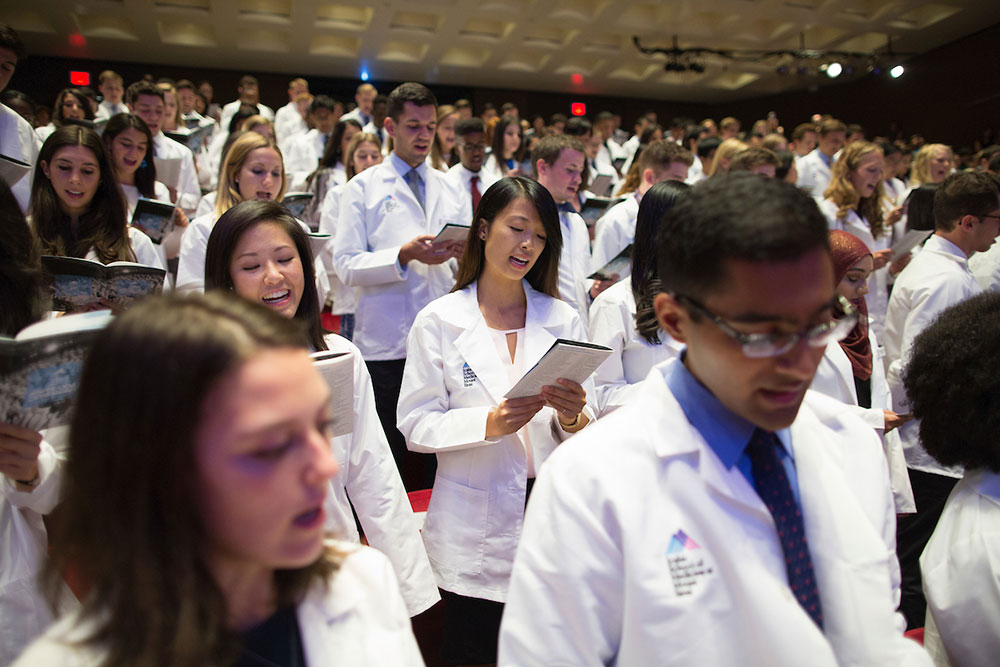 The following is the second in a two-part reflection piece written by Kamini Doobay, Class of 2015, during her Art and Science of Medicine (ASM) class. View part one.
The following is the second in a two-part reflection piece written by Kamini Doobay, Class of 2015, during her Art and Science of Medicine (ASM) class. View part one.
The progress of science has transformed the study of human disease and advancing technology is allowing for tools to combat traditional gaps in knowledge. There are so many high-tech gadgets that aid us in diagnosing and treating diseases. Icahn School of Medicine at Mount Sinai is revolutionizing medical education by providing state of the art instruments in the classroom and clinic. We are able to use handheld ultrasound machines in our ‘Art and Science of Medicine’ course to become familiar with useful clinical skills earlier on in our careers. This is truly incredible.
However, we cannot forsake the tools of compassion and listening, for it is the presence of the physician that kindles the light of hope in the patient’s period of perhaps unbearable pain and despair. In disease and dying, the body becomes alienated from the self. Physicians, witnessing this struggle, assist patients in navigating that which is unfamiliar and uncertain.
After learning basic science and pharmacology, it will not be so difficult to write a prescription for our patients or to know what procedures and tests to order. It is not just about treating symptoms or prescribing medications; physicians become part of patients’ stories as they unfold.
Dr. Fierer sat with each one of his patients and spoke to them not as an authoritative figure, not as the physician who has a monopoly on medical wisdom but as their partner in a therapeutic alliance. Though he may have been behind with two other patients sitting in the waiting area and also possibly uncomfortable in the hot and stuffy exam room, he focused on his patients, what they had to say and noted their fears, struggles, triumphs and each detail they chose not to leave out.
Similarly, Dr. Permumalswami was a pleasure to see in action. On the first day that I met Mr. D, an older gentleman suffering from cirrhosis, hepatitis C and in need of a liver transplant, he disclosed to me that he tells Dr. Perumalswami “everything.” Their relationship is a special one – where she is honest, open and truly compassionate. Though she does not give him false hope, she always reminds him that there is hope and she is fighting for him and with him.
The extraordinary physician greets each new day with freshness, ready to experience anew their sacred relationships with patients and feel that thrill, that passion that brought them into this field. He or she is aware of his or her own personal evolution and is a lifelong learner, capitalizing on unique talents and gifts and learning from each blunder. He or she is not just a scientifically competent, skilled individual waiting to solve intricate puzzles but a traveler along a journey – ready to participate in a shared struggle. However difficult it may be, the extraordinary physician rises to the call to listen to their patients, grasp and honor what they are being told and are moved to act on their patients’ behalf.
So, while I was learning the basic components of the pulmonary exam, I discovered that the oneness I can achieve with fellow individuals is so powerful. It is a stimulus for my own self-realization but also allows for an increased capacity to provide compassion, courage, joy and strength to those in need. From now on, I will breathe with my patient, speak with my patient, rejoice with my patient and fight with my patient.
I end this reflection with a quote from a mentor of mine, Dr. Michael Lockshin, and Alida Brill who are describing their relationship as physician and patient, but more importantly as two individuals working together to combat illness:
“We think of ourselves as collaborating cartographers, each charting a world we both know, but using different mapmaker’s tools. We observe, take note, discuss, and learn from each other. Our conversation is often true dialogue – interaction, translation, comprehension, persuasion, compromise – those human qualities necessary to the success of any intense and intimate relationship.” – Dancing at the River’s Edge
 Kamini Doobay is in ISMMS’s PORTAL program, as a MD/MSCR Candidate, Class of 2017.
Kamini Doobay is in ISMMS’s PORTAL program, as a MD/MSCR Candidate, Class of 2017.






